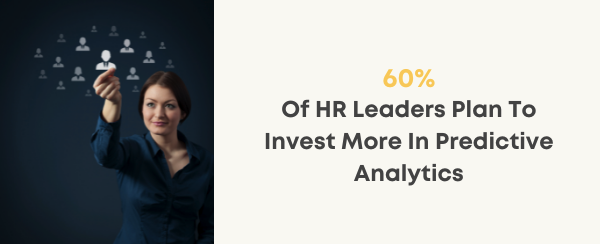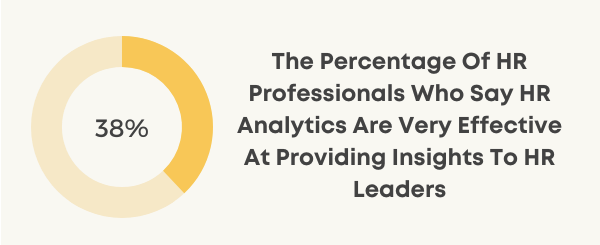HR analytics statistics tell us how this is a growing area that has not yet reached its full potential.
HR analytics, or people analytics, are slowly transforming human resources. With their help, employers and managers can make logical decisions about the workforce and their employees.
Let’s see which statistics on HR analytics can be of help then!
Key HR Analytics Statistics
- 60% of HR leaders plan to invest more in predictive analytics.
- Only 5% of companies utilize talent analytics effectively.
- Analytics is the main HR initiative for 20% of HR leaders.
- 29% of companies create a positive change with people analytics.
10 HR Analytics Statistics
1. 85% of HR professionals believe people analytics will play a big role in the future.
According to a study from LinkedIn, the global rate of HR professionals who believe people analytics will play a big role in the future is 85%. Moreover, the rate is even higher in India, where 92% of HR professionals think the same. Also, so do 90% of South Asian professionals.
Source: LinkedIn
2. More than seven in 10 HR professionals use people analytics to measure and improve HR operations performance.
Not only are HR professionals saying they believe in the importance of people analytics, but some are already utilizing them. According to the HR statistical analysis, 72% of HR professionals use people analytics to measure and improve the performance of HR operations.
Source: LinkedIn
3. 60% of HR leaders planned to invest more in predictive analytics between 2019 and 2021.
In the two years between 2019 and 2021, 60% of HR leaders reported they plan to invest more in predictive analytics. Likewise, 53% said they would invest more in enhanced process automation, and 43% in artificial intelligence.
Source: KPMG


4. Only 5% of companies believe they are effective in tracking and using talent analytics.
CEB Global researched trends on HR leaders in 2016 and came to the following conclusion. Only 5% of organizations use talent analytics effectively. Yet, it has a big potential. Moreover, only 12% of companies use predictive analytics for talent decision-making. However, 49% hope to do so in the future.
Source: CEB Global/Gartner
5. Only 20% of HR leaders report their main HR initiative will be analytics.
According to a KPMG report from 2019, only one in five HR leaders (20%) said they would focus on analytics as their primary HR initiative in the next couple of two years. On top of that, 12% also said that analytics was their top management concern.
Source: KPMG
6. Barely 37% of HR executives are very confident they can transform the workforce with AI and analytics.
Just over one in three HR executives (37%) report feeling very confident they can transform the workforce with analytics and artificial intelligence. However, around 66% of them do agree that the workforce is undergoing a digital transformation.
Source: KPMG
7. To choose high potential and identify future leaders, 58% of HR leaders need improved HR analytics.
According to HR and leadership statistics, 58% of HR leaders mostly need improved HR analytics so that they can identify high potential, as well as future leaders. This is according to CEB Global data report.
Source: CEB Global/Gartner
8. 38% of HR professionals say HR analytics are very effective at providing insights to HR leaders.
Compared to other stakeholders, HR professionals say that HR analytics are more effective at providing insights to HR leaders. This is according to 38% of HR professionals who participated in The State of HR Analytics 2021 report.
Source: HR.com


9. Only 29% believe their companies are good or very good at making a positive change based on people analytics.
First of all, only 44% of companies are good or very good at collecting people analytics. Moreover, according to The State of HR Analytics 2021 report, only 29% of respondents believe their companies are good or very good at making a positive change by using people analytics.
Source: HR.com
10. People analytics is a top priority for 70% of company executives.
When it comes to people analytics, seven in 10 company executives say that this is their top priority. However, it is interesting to see that companies are approaching people analytics with different team sizes, compositions, and organizations.
Source: Knowledge@Wharton
Final Verdict
In conclusion, HR analytics statistics tell us how different companies are approaching HR analytics and how important they are to them. Moreover, HR statistics can tell us more about the state of the industry around the world and how HR professionals can utilize these figures for success. Finally, human resource management statistics also tell us about the trends of hiring, recruiting, and interviewing job candidates.

































Find Us on Socials